Exploring the Use of Virtual Reality to Support Environmentally Sustainable Behavior: A Framework to Design Experiences
Abstract
1. Introduction
- Summing behaviors’ effects: displaying collective and long-term consequences
- Providing a journey in space and time
- Creating a symbolic and concrete representation
- Presenting and evaluating future solutions
- Testing future solutions with users
2. Related Work
3. Systematic Review Methodology
4. Framework Behavioral Spheres
- Emotional—related to affection, fear and connection with nature.
- Rational—related to information and understanding of systems and phenomena.
- Practical—related to knowhow and decision making.
5. Framework Elements and Categories
5.1. Aim of the VR Experience
- Environmental connection: Affection and responsibility towards nature
- Knowledge and skills: Awareness of how human behavior impact on the environment;
- Testing and presenting solutions: Understanding of the effects of decisions
5.2. Types of VR Experience
- Explorations: Raising awareness through emotional involvement
- Games: Raising interest and providing knowledge through engagement
- Simulations: Providing understanding through making predictions and testing solutions
5.3. Level of Immersion, Devices, and Stimuli
5.4. Single- and Multiuser Applications
5.5. Realism or Symbolic Representations
6. The Framework as a Tool to Orient the Design of VR Experiences Considering Behavioral Dimensions
7. How VR Applications Will Impact the Design of Sustainable Solutions
8. Conclusions
Author Contributions
Funding
Data Availability Statement
Conflicts of Interest
References
- Griggs, D.; Stafford-Smith, M.; Gaffney, O.; Rockström, J.; Öhman, M.C.; Shyamsundar, P.; Steffen, W.; Glaser, G.; Kanie, N.; Noble, I. Sustainable development goals for people and planet. Nature 2013, 495, 305–307. [Google Scholar] [CrossRef] [PubMed]
- Langevin, J.; Wen, J.; Gurian, P.L. Quantifying the human–building interaction: Considering the active, adaptive occupant in building performance simulation. Energy Build. 2016, 117, 372–386. [Google Scholar] [CrossRef]
- Larson, K.L.; Edsall, R.M. The impact of visual information on perceptions of water resource problems and management alternatives. J. Environ. Plan. Manag. 2010, 53, 335–352. [Google Scholar] [CrossRef]
- Kirilenko, A.; Chivoiu, B.; Crick, J.; Ross-Davis, A.; Schaaf, K.; Shao, G.; Singhania, V.; Swihart, R. An Internet-based decision support tool for non-industrial private forest landowners. Environ. Model. Softw. 2007, 22, 1498–1508. [Google Scholar] [CrossRef]
- Markowitz, D.M.; Laha, R.; Perone, B.P.; Pea, R.D.; Bailenson, J.N. Immersive virtual reality field trips facilitate learning about climate change. Front. Psychol. 2018, 9, 2364. [Google Scholar] [CrossRef]
- Barbalios, N.; Ioannidou, I.; Tzionas, P.; Paraskeuopoulos, S. A model supported interactive virtual environment for natural resource sharing in environmental education. Comput. Educ. 2013, 62, 231–248. [Google Scholar] [CrossRef]
- Schott, C. Virtual fieldtrips and climate change education for tourism students. J. Hosp. Leis. Sport Tour. Educ. 2017, 21, 13–22. [Google Scholar] [CrossRef]
- Chirico, A.; Scurati, G.W.; Maffi, C.; Huang, S.; Graziosi, S.; Ferrise, F.; Gaggioli, A. Designing virtual environments for attitudes and behavioral change in plastic consumption: A comparison between concrete and numerical information. Virtual Real. 2020. [Google Scholar] [CrossRef]
- Roider, O.; Wegener, S.; Stark, J.; Judmaier, P.; Michelberger, F.; Barberi, A. Merging Virtual World with Real-Life Behavior: A Concept for a Smartphone App to Influence Young People’s Travel Behavior. Transp. Res. Rec. 2019, 2673, 241–250. [Google Scholar] [CrossRef]
- Breves, P.; Heber, V. Into the wild: The effects of 360 immersive nature videos on feelings of commitment to the environment. Environ. Commun. 2020, 14, 332–346. [Google Scholar] [CrossRef]
- Fletcher, R. Gaming conservation: Nature 2.0 confronts nature-deficit disorder. Geoforum 2017, 79, 153–162. [Google Scholar] [CrossRef]
- Khashe, S.; Lucas, G.; Becerik-Gerber, B.; Gratch, J. Establishing social dialog between buildings and their users. Int. J. Hum. Comput. Interact. 2019, 35, 1545–1556. [Google Scholar] [CrossRef]
- Fox, J.; McKnight, J.; Sun, Y.; Maung, D.; Crawfis, R. Using a serious game to communicate risk and minimize psychological distance regarding environmental pollution. Telemat. Inform. 2020, 46, 101320. [Google Scholar] [CrossRef]
- Capellán-Pérez, I.; Álvarez-Antelo, D.; Miguel, L.J. Global Sustainability Crossroads: A Participatory Simulation Game to Educate in the Energy and Sustainability Challenges of the 21st Century. Sustainability 2019, 11, 3672. [Google Scholar] [CrossRef]
- Wang, C.H.; Wu, K.C.; Tsau, S.Y. Flow Learning Experience: Applying Marketing Theory to Serious Game Design. J. Educ. Comput. Res. 2019, 57, 417–447. [Google Scholar] [CrossRef]
- Liu, Q.; Cheng, Z.; Chen, M. Effects of environmental education on environmental ethics and literacy based on virtual reality technology. Electron. Libr. 2019, 37, 860–877. [Google Scholar] [CrossRef]
- Thaler, R.H.; Sunstein, C.R. Nudge: Improving Decisions about Health, Wealth, and Happiness; Yale University Press: New Haven, CO, USA, 2009. [Google Scholar]
- Hargreaves, T.; Nye, M.; Burgess, J. Making energy visible: A qualitative field study of how householders interact with feedback from smart energy monitors. Energy Policy 2010, 38, 6111–6119. [Google Scholar] [CrossRef]
- Irizar-Arrieta, A.; Casado-Mansilla, D.; Garaizar, P.; López-de Ipi na, D.; Retegi, A. User perspectives in the design of interactive everyday objects for sustainable behaviour. Int. J. Hum. Comput. Stud. 2020, 137, 102393. [Google Scholar] [CrossRef]
- Albertarelli, S.; Fraternali, P.; Herrera, S.; Melenhorst, M.; Novak, J.; Pasini, C.; Rizzoli, A.E.; Rottondi, C. A survey on the design of gamified systems for energy and water sustainability. Games 2018, 9, 38. [Google Scholar] [CrossRef]
- Scurati, G.W.; Ferrise, F. Looking Into a Future Which Hopefully Will Not Become Reality: How Computer Graphics Can Impact Our Behavior—A Study of the Potential of VR. IEEE Comput. Graph. Appl. 2020, 40, 82–88. [Google Scholar] [CrossRef]
- Rosedale, P. Virtual Reality: The Next Disruptor: A new kind of worldwide communication. IEEE Consum. Electron. Mag. 2017, 6, 48–50. [Google Scholar] [CrossRef]
- Steuer, J. Defining virtual reality: Dimensions determining telepresence. J. Commun. 1992, 42, 73–93. [Google Scholar] [CrossRef]
- Bryson, S. Virtual reality in scientific visualization. Commun. ACM 1996, 39, 62–71. [Google Scholar] [CrossRef]
- Coskun, A.; Zimmerman, J.; Erbug, C. Promoting sustainability through behavior change: A review. Des. Stud. 2015, 41, 183–204. [Google Scholar] [CrossRef]
- Blizzard, J.L.; Klotz, L.E. A framework for sustainable whole systems design. Des. Stud. 2012, 33, 456–479. [Google Scholar] [CrossRef]
- Withanage, C.; Hölttä-Otto, K.; Otto, K.; Wood, K. Design for sustainable use of appliances: A framework based on user behavior observations. J. Mech. Des. 2016, 138, 101102. [Google Scholar] [CrossRef]
- De Medeiros, J.F.; Da Rocha, C.G.; Ribeiro, J.L.D. Design for sustainable behavior (DfSB): Analysis of existing frameworks of behavior change strategies, experts’ assessment and proposal for a decision support diagram. J. Clean. Prod. 2018, 188, 402–415. [Google Scholar] [CrossRef]
- Tang, T.; Bhamra, T. Changing energy consumption behaviour through sustainable product design. In Proceedings of the DS 48: Proceedings DESIGN 2008, the 10th International Design Conference, Dubrovnik, Croatia, 19–22 May 2008. [Google Scholar]
- Bevan, C.; Green, D.P.; Farmer, H.; Rose, M.; Cater, K.; Stanton Fraser, D.; Brown, H. Behind the Curtain of the “Ultimate Empathy Machine” On the Composition of Virtual Reality Nonfiction Experiences. In Proceedings of the 2019 CHI Conference on Human Factors in Computing Systems, Glasgow, UK, 4–9 May 2019; pp. 1–12. [Google Scholar]
- Sutcliffe, A.G.; Poullis, C.; Gregoriades, A.; Katsouri, I.; Tzanavari, A.; Herakleous, K. Reflecting on the design process for virtual reality applications. Int. J. Hum. Comput. Interact. 2019, 35, 168–179. [Google Scholar] [CrossRef]
- Blom, K.J.; Beckhaus, S. The design space of dynamic interactive virtual environments. Virtual Real. 2014, 18, 101–116. [Google Scholar] [CrossRef]
- Vergara, D.; Rubio, M.P.; Lorenzo, M. On the design of virtual reality learning environments in engineering. Multimodal Technol. Interact. 2017, 1, 11. [Google Scholar] [CrossRef]
- Hammady, R.; Ma, M.; Ziad, A.K.; Strathearn, C. A Framework for Constructing and Evaluating the Role of MR as a Holographic Virtual Guide in Museums. Virtual Real. 2021. [Google Scholar] [CrossRef]
- Gaggioli, A.; Ferscha, A.; Riva, G.; Dunne, S.; Viaud-Delmon, I. Human Computer Confluence: Transforming Human Experience through Symbiotic Technologies; De Gruyter Open: Berlin, Germany, 2016. [Google Scholar]
- Stepanova, E.R.; Quesnel, D.; Riecke, B. Transformative experiences become more accessible through virtual reality. In Proceedings of the 2018 IEEE Workshop on Augmented and Virtual Realities for Good (VAR4Good), Reutlingen, Germany, 18 March 2018; pp. 1–3. [Google Scholar]
- Mitgutsch, K.; Alvarado, N. Purposeful by design? A serious game design assessment framework. In Proceedings of the International Conference on the Foundations of Digital Games, Raleigh, NC, USA, 29 May–1 June 2012; pp. 121–128. [Google Scholar]
- Bertrand, P.; Guegan, J.; Robieux, L.; McCall, C.A.; Zenasni, F. Learning empathy through virtual reality: Multiple strategies for training empathy-related abilities using body ownership illusions in embodied virtual reality. Front. Robot. AI 2018, 5, 26. [Google Scholar] [CrossRef]
- Ferrer-García, M.; Gutiérrez-Maldonado, J. The use of virtual reality in the study, assessment, and treatment of body image in eating disorders and nonclinical samples: A review of the literature. Body Image 2012, 9, 1–11. [Google Scholar] [CrossRef] [PubMed]
- Kollmuss, A.; Agyeman, J. Mind the gap: Why do people act environmentally and what are the barriers to pro-environmental behavior? Environ. Educ. Res. 2002, 8, 239–260. [Google Scholar] [CrossRef]
- Fogg, B.J. A behavior model for persuasive design. In Proceedings of the 4th International Conference on Persuasive Technology, Claremont, CA, USA, 26–29 April 2009; pp. 1–7. [Google Scholar]
- Sheppard, S.R. Landscape visualisation and climate change: The potential for influencing perceptions and behaviour. Environ. Sci. Policy 2005, 8, 637–654. [Google Scholar] [CrossRef]
- Paul, J.; Modi, A.; Patel, J. Predicting green product consumption using theory of planned behavior and reasoned action. J. Retail. Consum. Serv. 2016, 29, 123–134. [Google Scholar] [CrossRef]
- Lee, E.; Allen, A.; Kim, B. Interior design practitioner motivations for specifying sustainable materials: Applying the theory of planned behavior to residential design. J. Inter. Des. 2013, 38, 1–16. [Google Scholar] [CrossRef]
- Soliman, M.; Peetz, J.; Davydenko, M. The Impact of Immersive Technology on Nature Relatedness and Pro-Environmental Behavior. J. Media Psychol. 2017, 29, 8–17. [Google Scholar] [CrossRef]
- Truong, M.X.A.; Clayton, S. Technologically transformed experiences of nature: A challenge for environmental conservation? Biol. Conserv. 2020, 244, 108532. [Google Scholar] [CrossRef]
- Ahn, S.J.; Bostick, J.; Ogle, E.; Nowak, K.L.; McGillicuddy, K.T.; Bailenson, J.N. Experiencing nature: Embodying animals in immersive virtual environments increases inclusion of nature in self and involvement with nature. J. Comput. Mediat. Commun. 2016, 21, 399–419. [Google Scholar] [CrossRef]
- Ahn, S.J.; Fox, J.; Dale, K.R.; Avant, J.A. Framing virtual experiences: Effects on environmental efficacy and behavior over time. Commun. Res. 2015, 42, 839–863. [Google Scholar] [CrossRef]
- Dawson, P.; Levy, R. From science to survival: Using virtual exhibits to communicate the significance of polar heritage sites in the Canadian arctic. Open Archaeol. 2016, 2, 209–231. [Google Scholar] [CrossRef]
- Harwood, A.R.; Lovett, A.A.; Turner, J.A. Customising virtual globe tours to enhance community awareness of local landscape benefits. Landsc. Urban Plan. 2015, 142, 106–119. [Google Scholar] [CrossRef]
- Ballouard, J.M.; Brischoux, F.; Bonnet, X. Children prioritize virtual exotic biodiversity over local biodiversity. PLoS ONE 2011, 6, e23152. [Google Scholar] [CrossRef] [PubMed]
- Patle, D.S.; Manca, D.; Nazir, S.; Sharma, S. Operator training simulators in virtual reality environment for process operators: A review. Virtual Real. 2019, 23, 293–311. [Google Scholar] [CrossRef]
- Schroth, O.; Pond, E.; Sheppard, S.R. Evaluating presentation formats of local climate change in community planning with regard to process and outcomes. Landsc. Urban Plan. 2015, 142, 147–158. [Google Scholar] [CrossRef]
- Zeeman, W. Water management and multiple land use: The dutch approach: Competing and complementary functions in water management. Irrig. Drain. 2011, 60, 21–26. [Google Scholar] [CrossRef]
- Hamilton, A.; Trodd, N.; Zhang, X.; Fernando, T.; Watson, K. Learning through visual systems to enhance the urban planning process. Environ. Plan. Plan. Des. 2001, 28, 833–845. [Google Scholar] [CrossRef]
- Rocca, R.; Rosa, P.; Sassanelli, C.; Fumagalli, L.; Terzi, S. Integrating Virtual Reality and Digital Twin in Circular Economy Practices: A Laboratory Application Case. Sustainability 2020, 12, 2286. [Google Scholar] [CrossRef]
- Su, S.; Li, X.; Zhu, Y.; Lin, B. Dynamic LCA framework for environmental impact assessment of buildings. Energy Build. 2017, 149, 310–320. [Google Scholar] [CrossRef]
- Tagliabue, L.C.; Scurati, G.W.; Massetti, G.; Etzi, R.; Siyuan, H.; Ferrise, F.; Gallace, A.; Graziosi, S.; Carulli, M.; Bordegoni, M.; et al. Testing multisensory stimuli to drive thermal comfort and space perception using VR/AR: A design strategy to achieve energy saving. J. Archit. Res. Dev. 2020, 4. [Google Scholar] [CrossRef]
- Fokides, E.; Chachlaki, F. 3D Multiuser Virtual Environments and Environmental Education: The Virtual Island of the Mediterranean Monk Seal. Technol. Knowl. Learn. 2020, 25, 1–24. [Google Scholar] [CrossRef]
- Klein, S.A.; Hilbig, B.E. How virtual nature experiences can promote pro-environmental behavior. J. Environ. Psychol. 2018, 60, 41–47. [Google Scholar] [CrossRef]
- Nelson, K.M.; Anggraini, E.; Schlüter, A. Virtual reality as a tool for environmental conservation and fundraising. PLoS ONE 2020, 15, e0223631. [Google Scholar] [CrossRef] [PubMed]
- Hartmann, P.; Apaolaza-Ibá nez, V. Virtual nature experiences as emotional benefits in green product consumption: The moderating role of environmental attitudes. Environ. Behav. 2008, 40, 818–842. [Google Scholar] [CrossRef]
- Ritter, K.A., III; Stone, H.; Chambers, T.L. Empowering Through Knowledge: Exploring Place-based Environmental Education in Louisiana Classrooms Through Virtual Reality. ASEE Comput. Educ. (CoED) J. 2019, 10. [Google Scholar]
- Prada, R.; Prendinger, H.; Yongyuth, P.; Nakasoneb, A.; Kawtrakulc, A. AgriVillage: A Game to Foster Awareness of the Environmental Impact of Agriculture. Comput. Entertain. (CIE) 2015, 12, 1–18. [Google Scholar] [CrossRef]
- Dib, H.; Adamo-Villani, N. Serious sustainability challenge game to promote teaching and learning of building sustainability. J. Comput. Civ. Eng. 2014, 28, A4014007. [Google Scholar] [CrossRef]
- Duin, H.; Thoben, K.D. Serious gaming for sustainable manufacturing: A requirements analysis. In Proceedings of the 2011 17th International Conference on Concurrent Enterprising, Aachen, Germany, 20–22 June 2011; pp. 1–8. [Google Scholar]
- Scurati, G.; Nylander, J.; Hallstedt, S.; Ferrise, F.; Bertoni, M. Raising Value and Sustainability Awareness for Critical Materials: A Serious Game for the Aerospace Sector. In Proceedings of the Design Society: Design Conference, Dubrovnik, Croatia, 26–29 October 2020; Volume 1, pp. 737–746. [Google Scholar]
- Hamza, N.; Horne, M. Educating the designer: An operational model for visualizing low-energy architecture. Build. Environ. 2007, 42, 3841–3847. [Google Scholar] [CrossRef]
- Sussman, R.; Lavallee, L.F.; Gifford, R. Pro-environmental values matter in competitive but not cooperative commons dilemmas. J. Soc. Psychol. 2016, 156, 43–55. [Google Scholar] [CrossRef]
- Filter, E.; Eckes, A.; Fiebelkorn, F.; Büssing, A.G. Virtual Reality Nature Experiences Involving Wolves on YouTube: Presence, Emotions, and Attitudes in Immersive and Nonimmersive Settings. Sustainability 2020, 12, 3823. [Google Scholar] [CrossRef]
- Kim, K.; Rosenthal, M.Z.; Zielinski, D.J.; Brady, R. Effects of virtual environment platforms on emotional responses. Comput. Methods Programs Biomed. 2014, 113, 882–893. [Google Scholar] [CrossRef] [PubMed]
- Somrak, A.; Humar, I.; Hossain, M.S.; Alhamid, M.F.; Hossain, M.A.; Guna, J. Estimating VR Sickness and user experience using different HMD technologies: An evaluation study. Future Gener. Comput. Syst. 2019, 94, 302–316. [Google Scholar] [CrossRef]
- Fulton, E.A.; Boschetti, F.; Sporcic, M.; Jones, T.; Little, L.R.; Dambacher, J.M.; Gray, R.; Scott, R.; Gorton, R. A multi-model approach to engaging stakeholder and modellers in complex environmental problems. Environ. Sci. Policy 2015, 48, 44–56. [Google Scholar] [CrossRef]
- Hsu, W.C.; Tseng, C.M.; Kang, S.C. Using exaggerated feedback in a virtual reality environment to enhance behavior intention of water-conservation. J. Educ. Technol. Soc. 2018, 21, 187–203. [Google Scholar]
- Bailey, J.O.; Bailenson, J.N.; Flora, J.; Armel, K.C.; Voelker, D.; Reeves, B. The impact of vivid messages on reducing energy consumption related to hot water use. Environ. Behav. 2015, 47, 570–592. [Google Scholar] [CrossRef]
- Hales, R.; Caton, K. Proximity ethics, climate change and the flyer’s dilemma: Ethical negotiations of the hypermobile traveller. Tour. Stud. 2017, 17, 94–113. [Google Scholar] [CrossRef]
- Isaksson, O.; Eckert, C. Product Development 2040; Public Report; The Design Society: Glasgow, UK, 2020. [Google Scholar]
- Robert, O.; Iztok, P.; Borut, B. Real-Time manufacturing optimization with a simulation model and virtual reality. Procedia Manuf. 2019, 38, 1103–1110. [Google Scholar] [CrossRef]
- Scurati, G.W.; Ferrise, F.; Bertoni, M. Sustainability awareness in organizations through gamification and serious games: A systematic mapping. In Proceedings of the NordDesign 2020—DS 101, Lyngby, Denmark, 12–14 August 2020; pp. 1–10. [Google Scholar]
- Gifford, R. Environmental psychology matters. Annu. Rev. Psychol. 2014, 65, 541–579. [Google Scholar] [CrossRef]
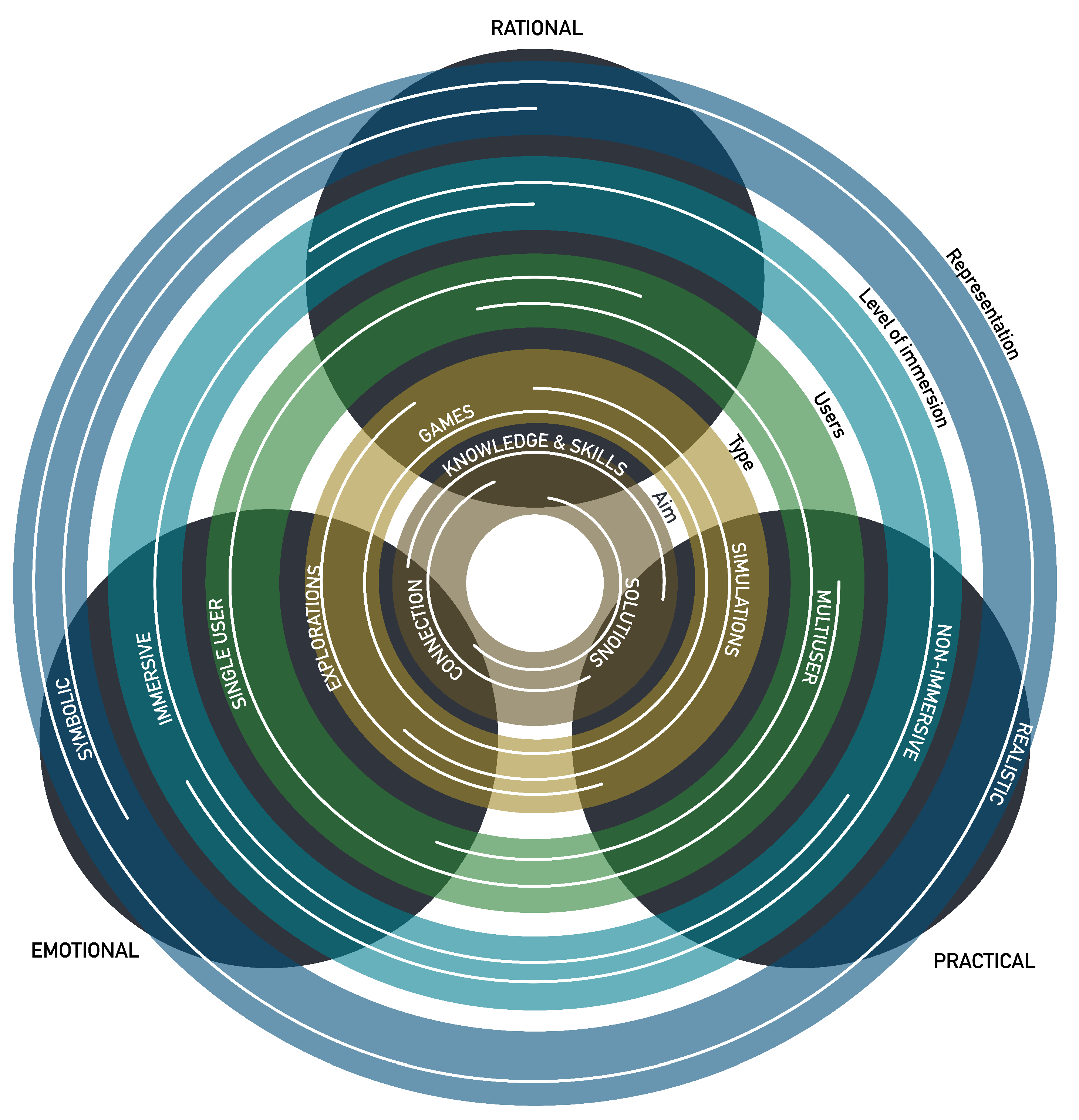
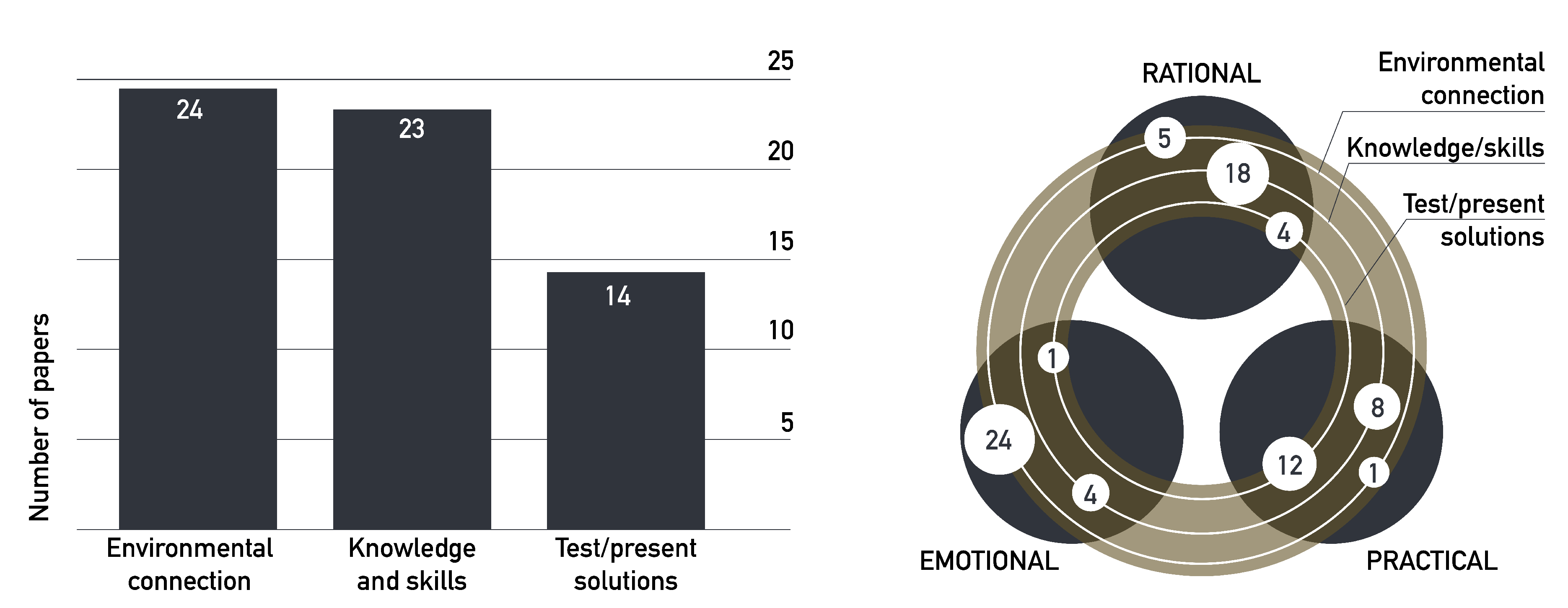
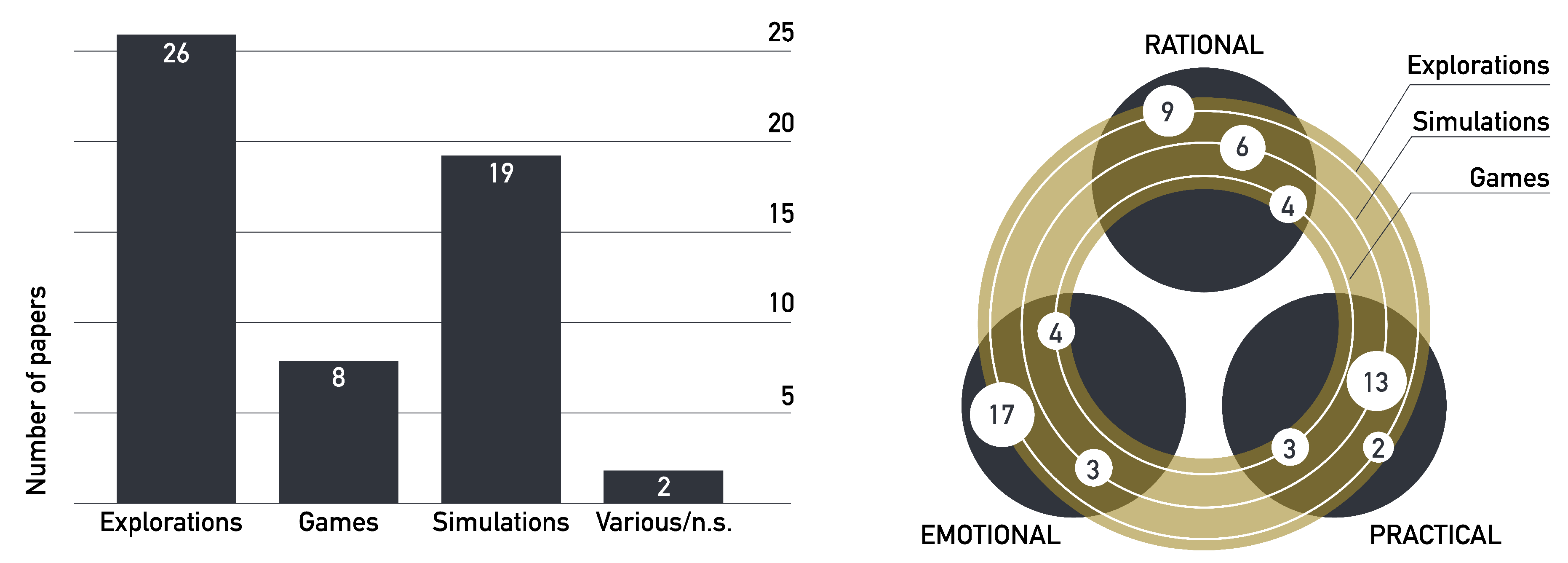
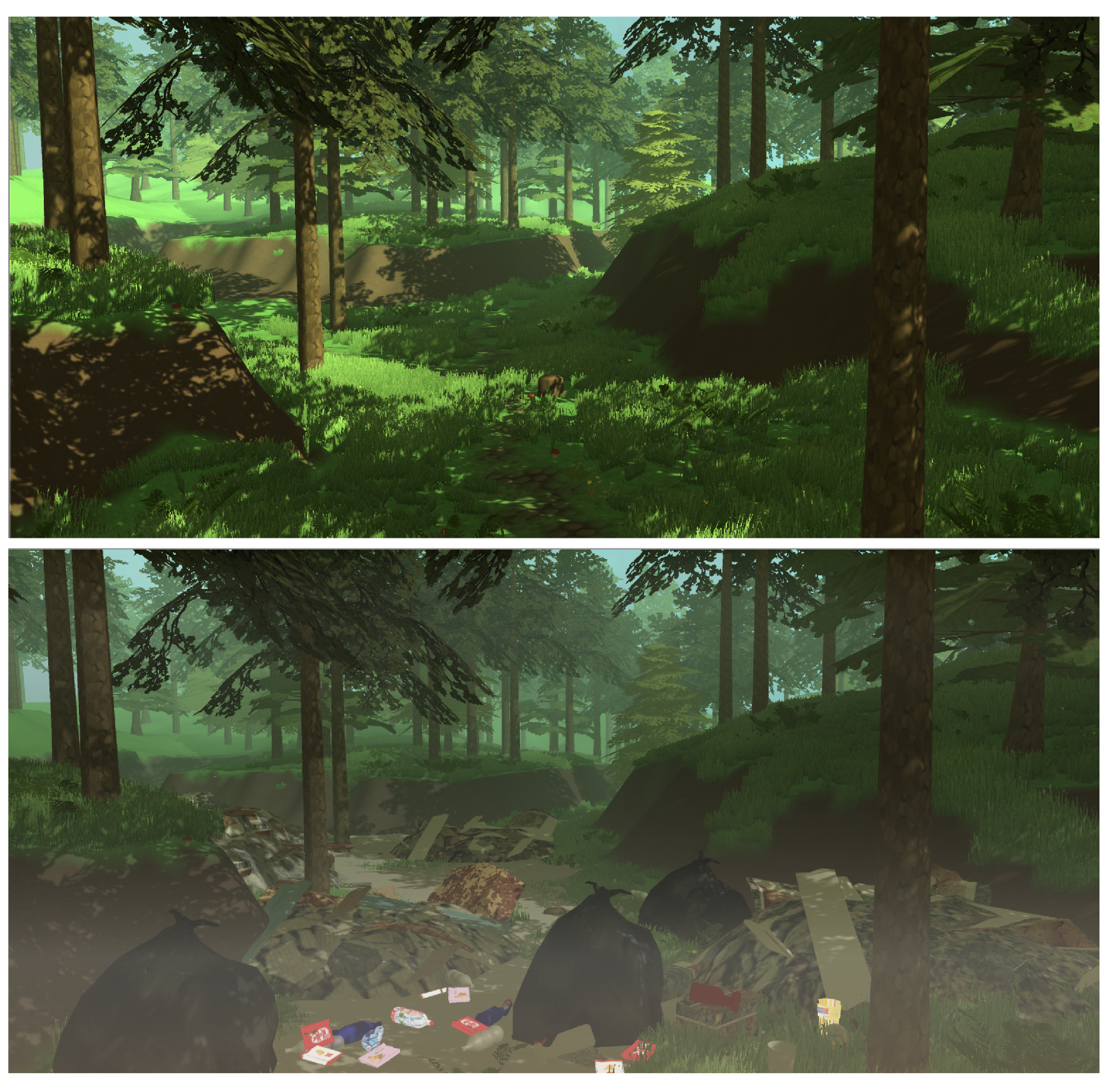
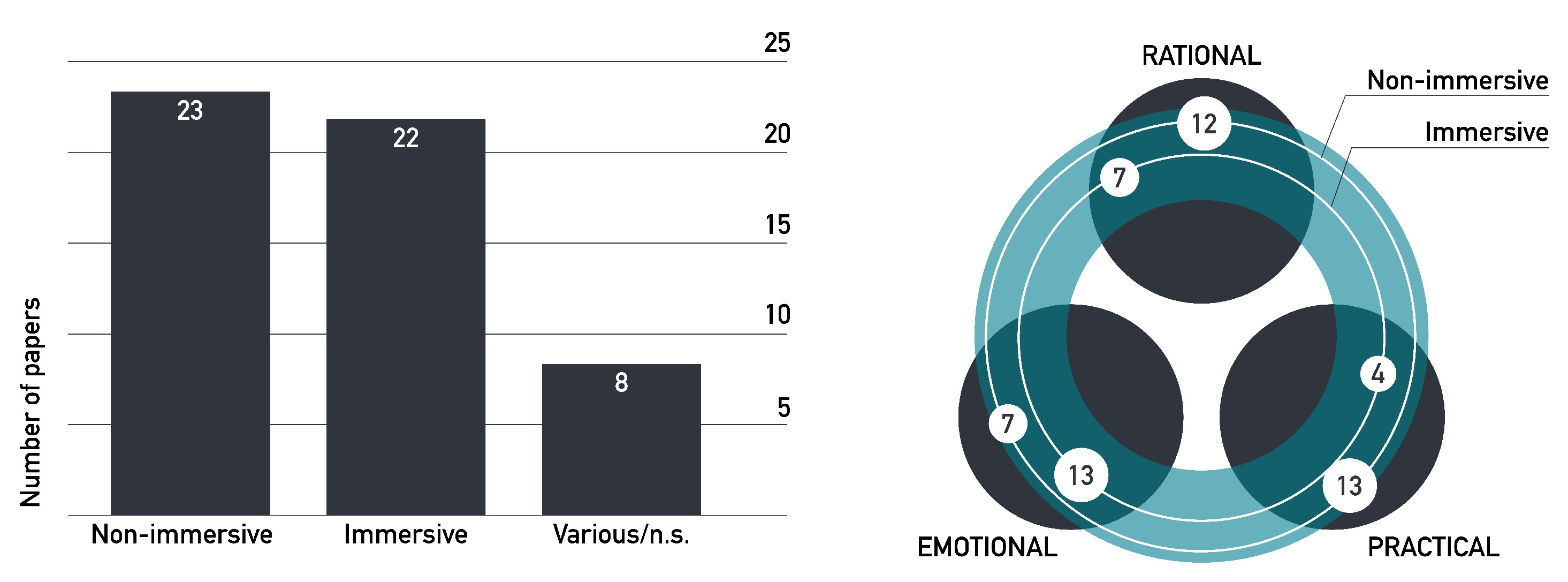
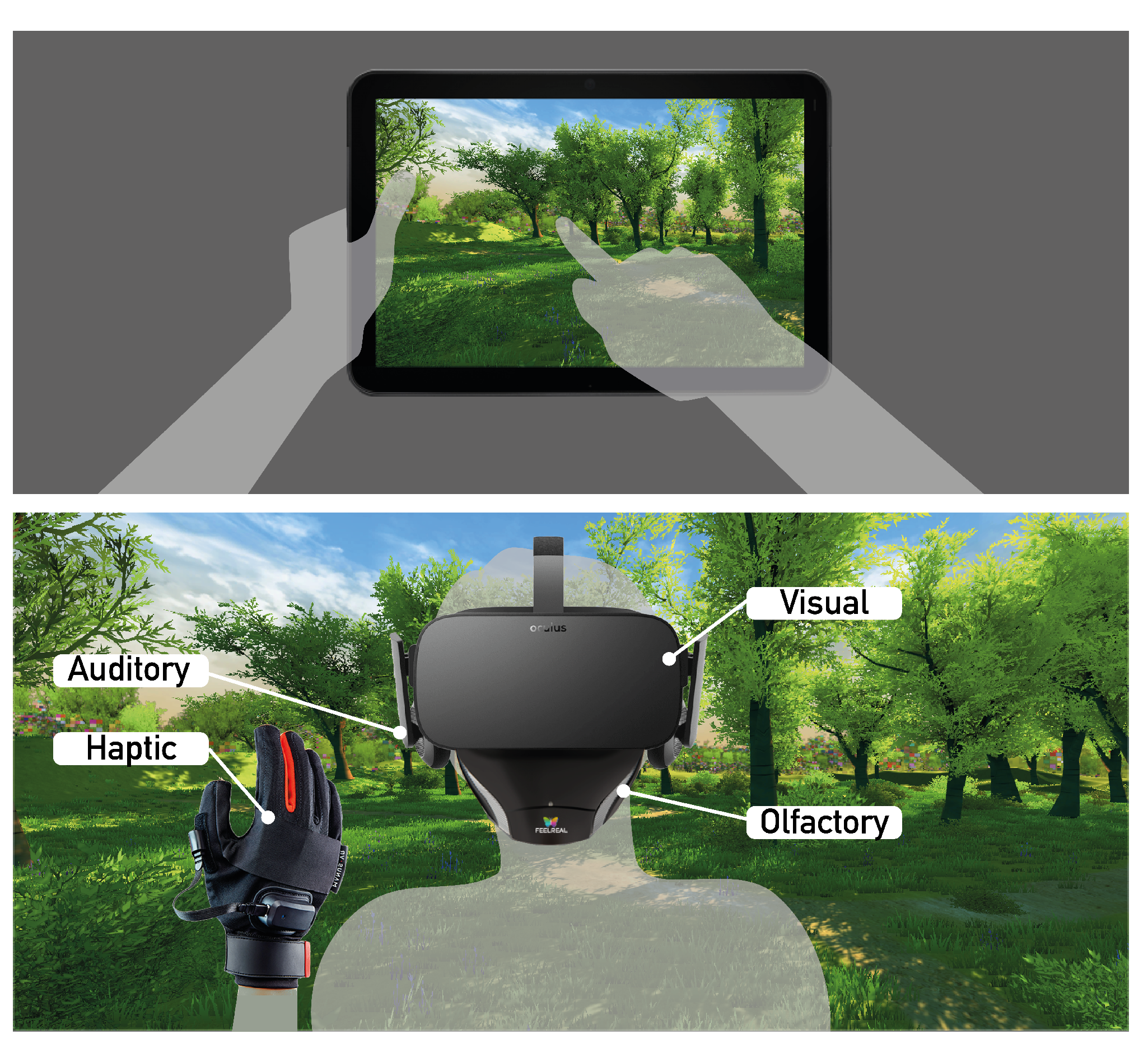
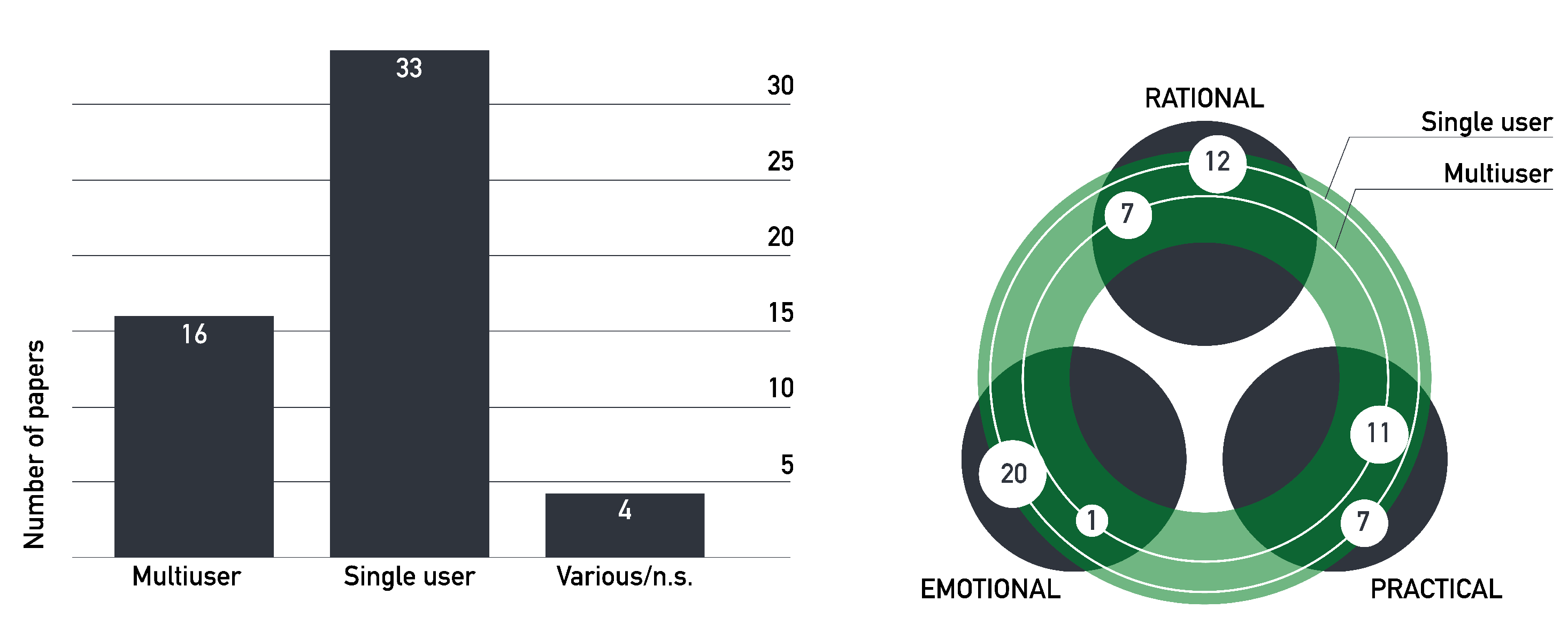
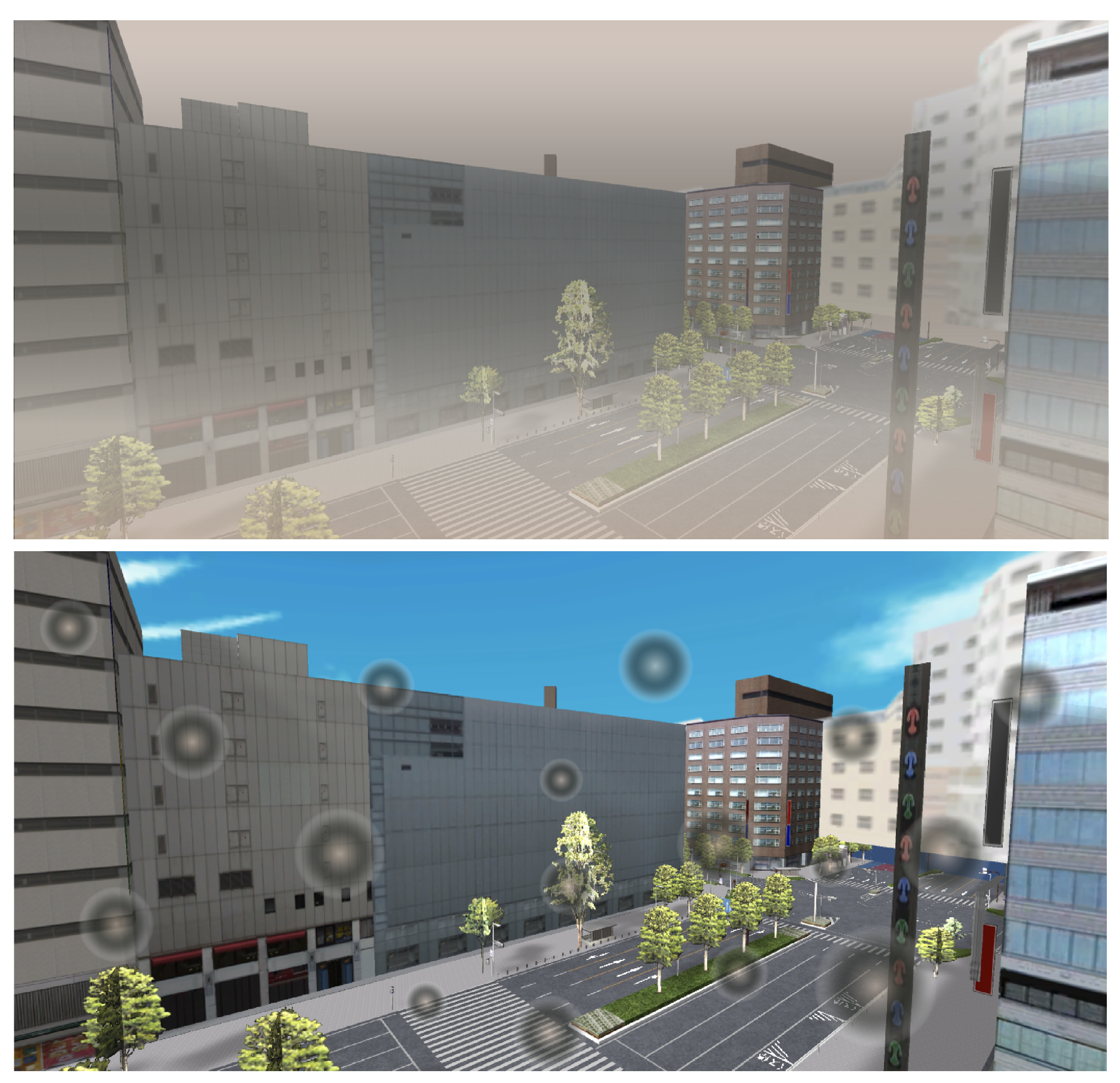
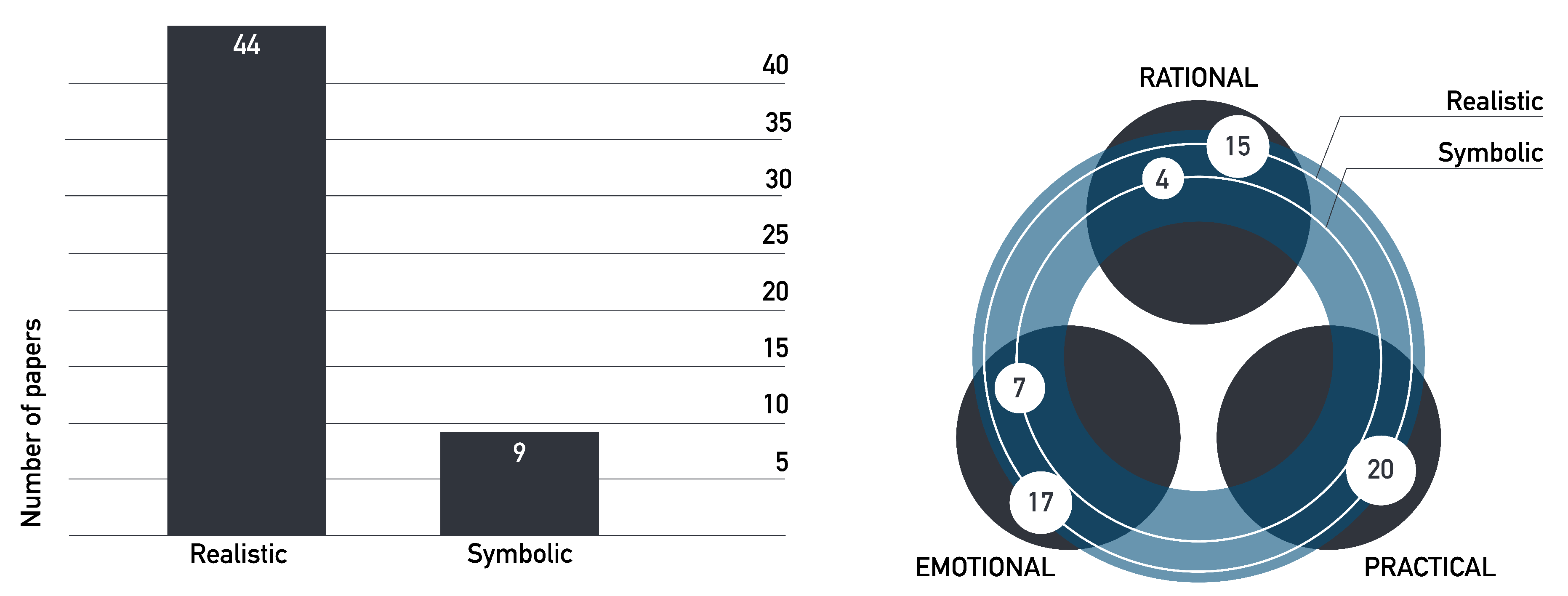
| Search Words Related to VR | Search Words Related to Behavior | Search Words Related to Environmental Sustainability |
|---|---|---|
| Virtual Reality | Behavior */Behaviour * | Sustainab * |
| Virtual Environment * | Attitude * | Environmental |
| Awareness | Pollution | |
| Global warming | ||
| Climate change |
Publisher’s Note: MDPI stays neutral with regard to jurisdictional claims in published maps and institutional affiliations. |
© 2021 by the authors. Licensee MDPI, Basel, Switzerland. This article is an open access article distributed under the terms and conditions of the Creative Commons Attribution (CC BY) license (http://creativecommons.org/licenses/by/4.0/).
Share and Cite
Scurati, G.W.; Bertoni, M.; Graziosi, S.; Ferrise, F. Exploring the Use of Virtual Reality to Support Environmentally Sustainable Behavior: A Framework to Design Experiences. Sustainability 2021, 13, 943. https://doi.org/10.3390/su13020943
Scurati GW, Bertoni M, Graziosi S, Ferrise F. Exploring the Use of Virtual Reality to Support Environmentally Sustainable Behavior: A Framework to Design Experiences. Sustainability. 2021; 13(2):943. https://doi.org/10.3390/su13020943
Chicago/Turabian StyleScurati, Giulia Wally, Marco Bertoni, Serena Graziosi, and Francesco Ferrise. 2021. "Exploring the Use of Virtual Reality to Support Environmentally Sustainable Behavior: A Framework to Design Experiences" Sustainability 13, no. 2: 943. https://doi.org/10.3390/su13020943
APA StyleScurati, G. W., Bertoni, M., Graziosi, S., & Ferrise, F. (2021). Exploring the Use of Virtual Reality to Support Environmentally Sustainable Behavior: A Framework to Design Experiences. Sustainability, 13(2), 943. https://doi.org/10.3390/su13020943







